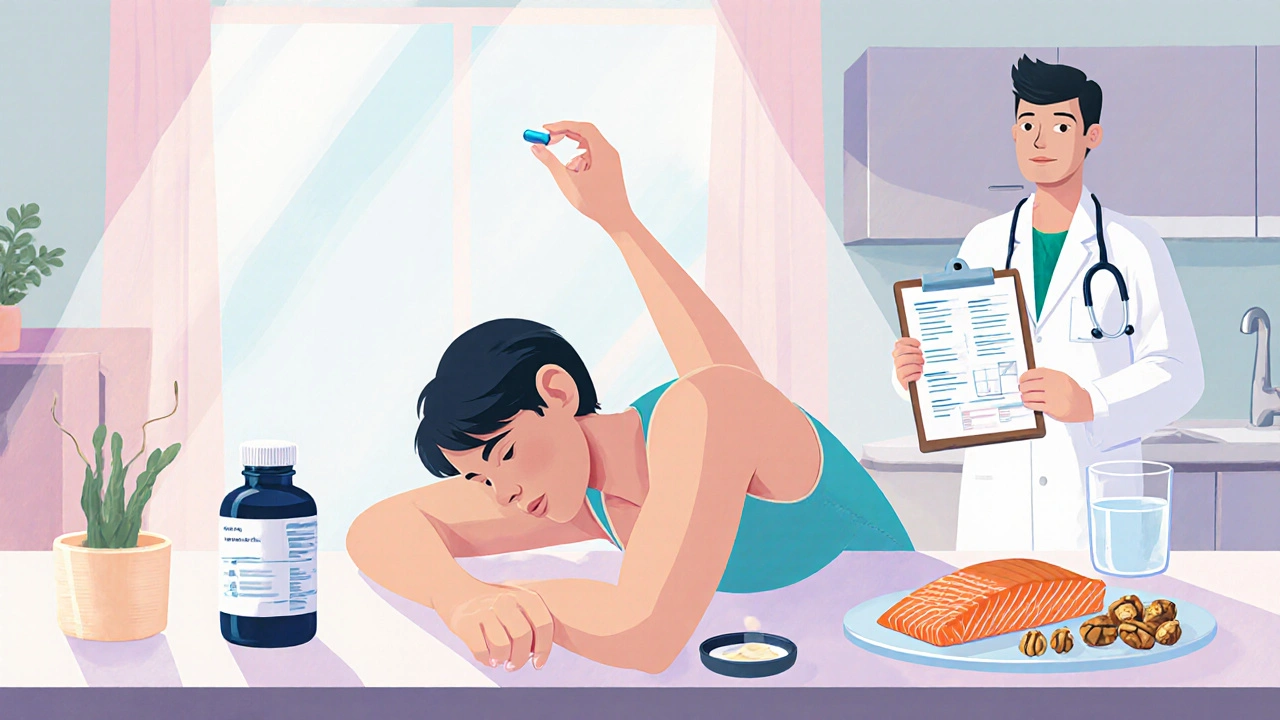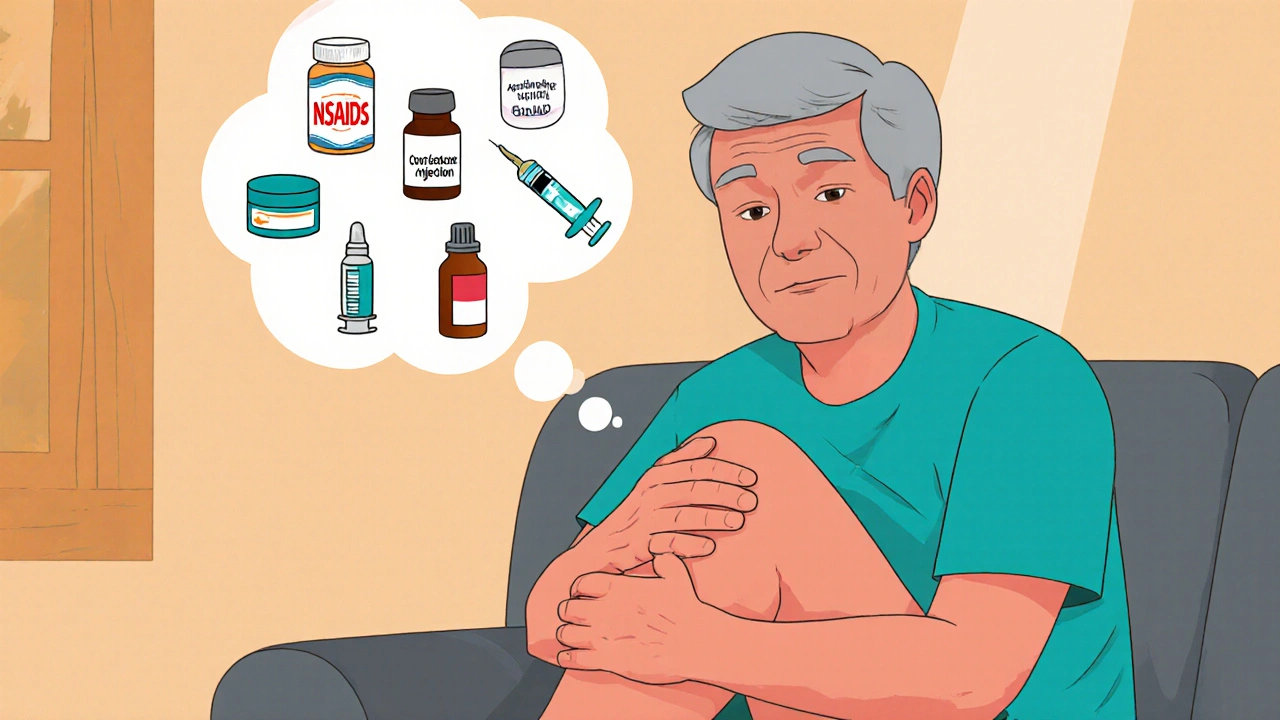When the ache in your knee or elbow starts controlling your day, the first thing you look for is relief. Understanding joint pain medication is the fastest way to get back to moving without fearing the next twinge.
What Actually Causes Joint Pain?
Joint pain isn’t a single disease; it’s a symptom that pops up when cartilage wears down, inflammation flares, or the joint capsule gets irritated. In osteoarthritis, the cartilage that cushions the ends of bones slowly erodes, exposing bone on bone and sparking pain. Rheumatoid arthritis, on the other hand, is an autoimmune attack that inflames the synovial lining, leading to swelling and stiffness. Even simple overuse, such as climbing stairs repeatedly, can trigger micro‑injuries that send pain signals to the brain.
Why Turn to Medication?
Medication steps in to break the pain‑signal chain, reduce inflammation, and, in some cases, protect the joint from further damage. While lifestyle tweaks-like losing weight or strengthening the surrounding muscles-are essential, drugs provide the immediate relief needed to stay active while those longer‑term habits take hold.
Medication for Joint Pain is a broad term that covers several drug families, each with its own strengths and trade‑offs.
Below is a quick look at the most common categories you’ll encounter in a doctor’s office or pharmacy shelf.
NSAIDs
Non‑steroidal anti‑inflammatory drugs, like ibuprofen (200 mg - 400 mg every 4‑6 hours) and naproxen (250 mg - 500 mg twice daily), knock down prostaglandin production, easing both pain and swelling. They’re the go‑to for acute flare‑ups because they start working within an hour.
Acetaminophen
Acetaminophen (paracetamol) isn’t an anti‑inflammatory, but it’s gentle on the stomach and liver when kept under 3 g per day. It’s a solid first‑line choice for mild to moderate pain, especially for people who can’t tolerate NSAIDs.
Corticosteroids
When inflammation is severe, a short‑term burst of steroids-either oral prednisone (5‑20 mg daily) or an intra‑articular injection of methylprednisolone-can reset the immune response. The pain relief can last weeks to months, but repeated use raises the risk of cartilage thinning and bone loss.

Opioids
For breakthrough pain that other drugs can’t tame, a low‑dose opioid such as tramadol (50 mg twice daily) may be prescribed. Opioids are powerful, but they carry a high chance of dependence, constipation, and sedation, so they’re reserved for short‑term, severe scenarios.
Disease‑Modifying Osteoarthritis Drugs (DMOADs)
Research is still racing to validate true DMOADs, but agents like glucosamine sulfate (1500 mg daily) and diacerein (50 mg twice daily) are marketed to slow cartilage loss. Evidence is mixed, yet many patients use them as part of a holistic plan.
Topical Analgesics
For localized pain, creams or gels containing diclofenac (1‑3% concentration) or capsaicin (0.025%‑0.075%) can be applied directly to the skin. They avoid systemic side effects and are especially handy for knee or hand joints.
How to Choose the Right Medication
Picking a drug isn’t a one‑size‑fits‑all decision. Consider these factors:
- Joint type: Weight‑bearing joints (knees, hips) often need stronger anti‑inflammatory coverage.
- Pain severity: Mild‑moderate pain = NSAIDs or acetaminophen; severe = short‑term steroids or opioids.
- Age & comorbidities: Seniors with stomach ulcers should avoid high‑dose NSAIDs; diabetics need caution with steroids.
- Drug interactions: Blood thinners, antihypertensives, and certain antidepressants can clash with NSAIDs.
- Lifestyle goals: If you’re aiming for weight loss, a low‑dose NSAID plus exercise may be enough.
Talking through these points with your prescriber helps land on a plan that eases pain without creating new health problems.
Safety Tips and Common Side Effects
Every medication class has a safety profile you should know.
- NSAIDs: May cause stomach ulcer, kidney strain, or raise blood pressure. Take with food and stay hydrated.
- Acetaminophen: Overdose can lead to liver failure. Never exceed the daily limit.
- Corticosteroids: Short bursts are safer, but long‑term use can cause weight gain, mood swings, and bone thinning.
- Opioids: Risk of dependence, drowsiness, and constipation. Use the lowest effective dose and set a clear stop date.
- Topicals: May cause skin irritation or redness; wash hands after application.
If you notice unusual bruising, persistent GI upset, or unexplained fatigue, call your clinician right away.

Quick Comparison of Common Joint Pain Medications
| Medication Type | Typical Use | Onset of Relief | Common Side Effects | Prescription Needed? |
|---|---|---|---|---|
| NSAIDs | Inflammatory pain (OA, RA) | 30‑60 min | Stomach ulcer, kidney strain | Often OTC (higher doses Rx) |
| Acetaminophen | Mild‑moderate pain | 45‑90 min | Liver toxicity at high dose | OTC |
| Corticosteroid injection | Severe flare‑up, joint inflammation | Days to weeks | Joint cartilage thinning, systemic effects | Prescription |
| Opioids | Breakthrough severe pain | 15‑30 min | Dependence, constipation, drowsiness | Prescription |
| Topical NSAID | Localized knee/hand pain | 1‑2 hrs | Skin irritation | OTC or Rx (strength varies) |
Integrating Medication with Non‑Drug Strategies
Medications work best when paired with movement, weight control, and joint‑friendly activities. A 10‑minute daily range‑of‑motion routine can restore synovial fluid flow, while a balanced diet rich in omega‑3s (found in salmon, walnuts) helps keep inflammation low. When you’re on steroids, supplementing with calcium and vitamin D reduces bone loss risk.
When Medication Isn’t Enough
If pain persists despite optimal dosing, you might need to explore disease‑modifying therapies, joint injections (hyaluronic acid, platelet‑rich plasma), or even surgical options like arthroscopy or joint replacement. Consulting a rheumatologist or orthopedic surgeon ensures you’re not missing a treatable underlying condition.
Frequently Asked Questions
Can I mix NSAIDs with acetaminophen?
Yes. Combining a standard dose of ibuprofen (200 mg) with acetaminophen (500 mg) provides pain relief while lowering the risk of stomach irritation compared with high‑dose NSAIDs alone. Always stay within the daily limits for each drug.
How often is a steroid injection safe?
Most experts recommend no more than three injections per joint per year. Over‑use can accelerate cartilage wear and raise infection risk.
Are over‑the‑counter creams effective?
Topical NSAID gels (e.g., diclofenac 1‑3%) have solid evidence for reducing pain in knee osteoarthritis, especially when oral NSAIDs cause stomach upset.
What should I do if I miss a dose?
Take the missed dose as soon as you remember, unless it’s close to the next scheduled dose. Doubling up can increase side‑effects, so skip the missed one if the next dose is due within a few hours.
Is it safe to take pain meds while pregnant?
Acetaminophen is generally regarded as safe throughout pregnancy. NSAIDs should be avoided in the third trimester because they can affect fetal kidney function and prolong labor.
Key Takeaways
- Identify the underlying cause-OA, RA, injury-to match the right drug class.
- Start with the least aggressive option (acetaminophen or topical NSAID) and step up as needed.
- Monitor for side effects; keep a simple log of dosage, timing, and any new symptoms.
- Combine meds with weight management, gentle movement, and supportive braces for lasting relief.
- Regular check‑ins with your healthcare provider keep the plan safe and effective.
By understanding how each medication works, you can team up with your doctor to create a pain‑free routine that lets you stay active, enjoy hobbies, and avoid the trap of chronic discomfort.



My joints scream louder than any politics you folks ignore!
Stop whining; NSAIDs are the first line for acute joint pain, take ibuprofen 400 mg every 6 hours with food.
You think those pills are just chemicals? The big pharma labs are feeding us synthetic pain so we stay dependent. Every prescription is a little leash they tie around your knee. They hide the real cure behind endless studies you never see. I swear the FDA meetings are a theater of shadows, and we are the audience. Trust your own body, move more, and question the motives. The truth is out there, hidden in plain sight.
When you start an NSAID regimen, the first step is to pick the lowest effective dose. Ibuprofen 200 mg taken every 6 hours works for most mild to moderate flare‑ups. If pain persists, you can increase to 400 mg per dose but never exceed 1200 mg in a 24‑hour period without doctor approval. Always take the medication with food or a glass of milk to protect the stomach lining. Hydration is key because NSAIDs can strain the kidneys, especially in older adults. If you have high blood pressure, monitor it closely; NSAIDs may cause a slight increase. For patients with a history of ulcers, consider adding a proton‑pump inhibitor or switch to acetaminophen. Acetaminophen, while gentle on the gut, should stay below 3 g per day to avoid liver toxicity. In cases of severe inflammation, a short course of oral prednisone 5 mg daily can be used, but limit the duration to under two weeks to reduce bone loss risk. Intra‑articular steroid injections provide targeted relief and can last weeks, yet they should not be repeated more than three times per year. If you find oral options insufficient, a topical diclofenac gel applied to the affected joint offers localized pain control with minimal systemic exposure. Remember to wash your hands after applying topicals to avoid accidental eye contact. For breakthrough pain that does not respond to the above, a low‑dose tramadol may be prescribed, but watch for dizziness and constipation. Opioids should remain a last‑resort option and be tapered off as soon as the pain subsides. Throughout any medication plan, keep a simple log noting the drug, dose, time, and any side effects you experience. Share this log with your healthcare provider at each visit; it helps tailor the therapy and catch problems early. Finally, complement the pharmacologic approach with gentle range‑of‑motion exercises, weight management, and anti‑inflammatory foods like fatty fish and leafy greens. This combined strategy gives you the best chance at long‑term joint health.
In the quiet of a sore knee, we glimpse the fragility of our mortal vessel 🌿. Medications are but temporary bridges over the river of pain, urging us to seek deeper balance 🧘♀️. Choose wisely, for each pill writes a line in your body's own poem 🌟.
Great thoughts! Remember that every body is unique, so what works for one may not work for another 😊. Talk with your doctor, listen to your body, and stay supportive of each other's journeys 💪.
Whoa, folks, let’s turn that joint grind into a joint jam! 🎸 Crank up those low‑impact moves-think swimming, cycling, or a brisk walk in the park. Pair the meds with a splash of sunshine, a plate of rainbow veggies, and a playlist that makes your spine sway. You’ve got the power to bounce back brighter than a sunrise over the Rockies!
Indeed, integrating movement, nutrition, and appropriate pharmacotherapy creates a synergistic effect that promotes joint resilience. Maintaining adherence to the prescribed regimen while progressively increasing activity levels will likely yield measurable improvement in function. I am confident that, with diligent monitoring, a positive outcome is well within reach.